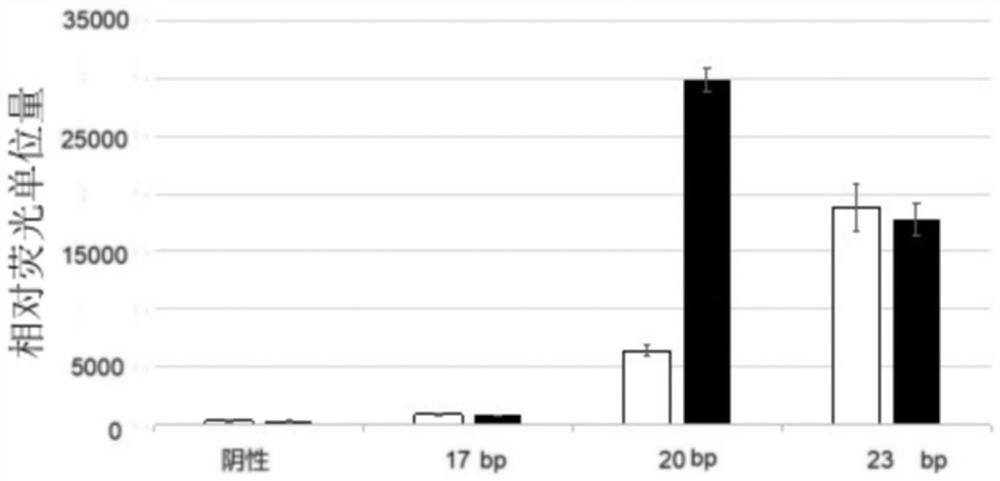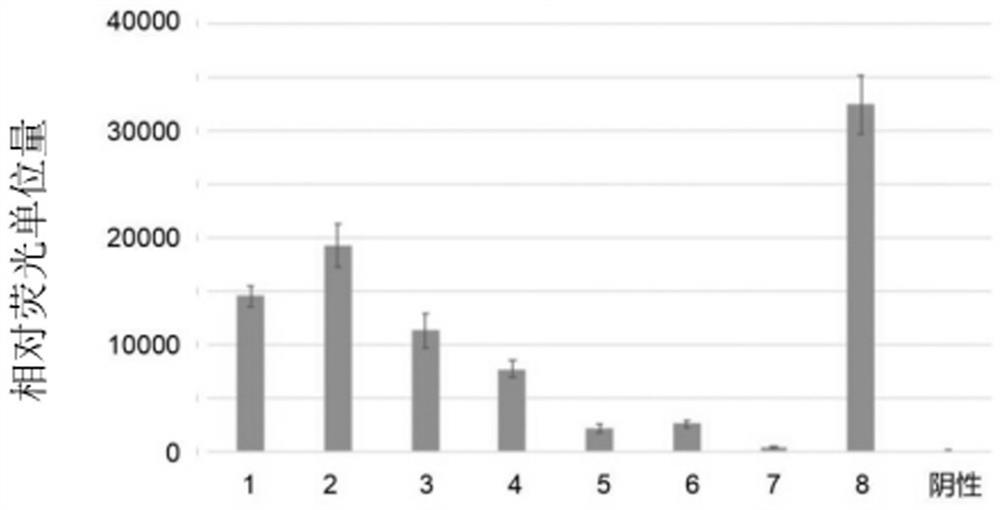Modified CrRNA fragment and African swine fever virus kit
A kit and fragment technology is applied in the field of modified CrRNA fragments and African swine fever virus kits to achieve the effects of high sensitivity, shortened detection time and strong specificity
- Summary
- Abstract
- Description
- Claims
- Application Information
AI Technical Summary
Problems solved by technology
Method used
Image
Examples
Embodiment 1
[0039] Embodiment 1, construction is used to detect the CrRNA of ASFV
[0040] Taking the T5 site and T8 site of the P72 gene of ASFV as the detection target, design guide sequences with lengths of 23bp, 20bp, and 17bp, respectively, and combine the guide sequence and the anchor sequence for the Cas12a protein into CrRNA in order to obtain better results. Cutting efficiency and reduce off-target rate. The constructed CrRNA is shown in Table 3:
[0041] Table 3 CrRNA sequences for testing
[0042] .
[0043] Construct a CRISPR / DX detection system (20 μl) for detecting ASFV, including: LBcas12a (1 μM) 1 μl; CrRNA (1 μM) 2 μl; probe (10 μM) 1 μl; RNase inhibitor 1 μl; Buffer2 2 μl; plasma 1 μl (7×10 9 copy / μl); water 10μl; MgCl 2 2 μl (17.5 mM); the reaction temperature is 47°C, and the reaction time is 20 minutes. The sequence of the fluorescent reporter molecule (probe) is 5'-FAM-CCCCCC-BHQ1-3'.
[0044] According to Table 3, CrRNA sequences of different lengths were syn...
Embodiment 2
[0045] Embodiment 2, CrRNA-DNA structural optimization design
[0046] (2-1) Select the T5 site of the P72 gene of ASFV to verify the effect of adding a DNA modification fragment to the 3' end of CrRNA in the CRISPR / DX detection system on the cutting efficiency. Construct detection system: LBcas12a (1μM) 1μl; CrRNA (1μM) 2μl; probe (10μM) 1μl; RNase inhibitor 1μl; Buffer2 2μl; plasma 0.5μl (7×10 9 copy / ul); water 10.5μl; MgCl 2 2 μl (17.5 mM); the reaction temperature is 47°C, and the reaction time is 20 minutes. The CrRNA is based on the RNA sequence targeting the T5 site, with T5-20 as the No. 1 CrRNA, and the No. 2 CrRNA to No. 8 CrRNA sequences are respectively modified with 5'-TATTATT-3' at the 3' end of T5-20 DNA sequence of 5'-AAATAAA-3', 5'-TTTATTT-3', 5'-TCCCGCC-3', 5'-TGGGGGG-3', 5'-TGGGCGGG-3' or 5'-TCCCCCC-3' .
[0047] The test results of each test system sample are as follows: figure 2 As shown, in the same positive plasmid detection, compared with the bas...
Embodiment 3
[0050] Example 3, Condition optimization of CRISPR / DX detection system
[0051] The reaction rate of the CRISPR / DX detection system is also related to multiple reaction conditions, including magnesium ion concentration, reaction temperature, target pairing and other factors. Therefore, a higher reaction rate can be obtained by adjusting various conditions. Based on the CRISPR / DX detection system in Example 2 (2-1), the CrRNA used was T8-23, and its magnesium ion concentration, reaction temperature and target selection were optimized respectively.
[0052] (3-1) Optimization of magnesium ion concentration.
[0053] Magnesium chloride solutions with concentrations of 17.5mM, 16.4mM, 15mM, 13mM, and 10mM were respectively prepared for the CRISPR / DX detection system to detect the same ASFV positive plasmid, and the reaction temperature was set at 37°C, which is commonly used in the CRISPR / DX detection system. Test results such as Figure 4 As shown, the RFU data of the detection...
PUM
 Login to View More
Login to View More Abstract
Description
Claims
Application Information
 Login to View More
Login to View More - R&D
- Intellectual Property
- Life Sciences
- Materials
- Tech Scout
- Unparalleled Data Quality
- Higher Quality Content
- 60% Fewer Hallucinations
Browse by: Latest US Patents, China's latest patents, Technical Efficacy Thesaurus, Application Domain, Technology Topic, Popular Technical Reports.
© 2025 PatSnap. All rights reserved.Legal|Privacy policy|Modern Slavery Act Transparency Statement|Sitemap|About US| Contact US: help@patsnap.com



